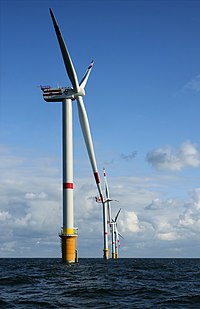
Photo from wikipedia
Abstract Wind turbines have considerable impact on flying animals, particularly bats, which are sometimes killed in large numbers by the moving rotors. A longstanding question remains why bats are attracted… Click to show full abstract
Abstract Wind turbines have considerable impact on flying animals, particularly bats, which are sometimes killed in large numbers by the moving rotors. A longstanding question remains why bats are attracted to wind turbines and risk their lives among the moving rotor blades. One hypothesis is that they feed on insects swarming around the turbine towers and another is that they congregate there to court. The two are not mutually exclusive and may occur more or less simultaneously. It has been difficult to distinguish these hypothesis, because techniques that permit observations of small insects over the relevant distances (~100 m) in the dark are lacking. In this study, we monitored insects at the top of a wind turbine using a novel high-resolution Scheimpflug lidar. The instrument was employed around dusk during ten late summer nights in 2018, with the principal aim to evaluate its performance under real field conditions. Insect swarms were observed near the top of the turbine tower on every night. They appeared in short intervals and varied in density, timing, exact location and size of the swarming insects from day to day. Swarms formed in the afternoon and either dispersed around sunset before the emergence of bats, or remained until darkness, when bats arrived at the turbine. Some of the bats fed there, as indicated by ultrasonic feeding-buzzes, and also engaged in social interactions possibly including courtship, as indicated by song-flights. Daily variation in the formation, dispersal and behavior of the insect swarms appeared to be influenced by temperature and wind speed and also differed among the insect species.
Journal Title: Ecological Indicators
Year Published: 2020
Link to full text (if available)
Share on Social Media: Sign Up to like & get
recommendations!